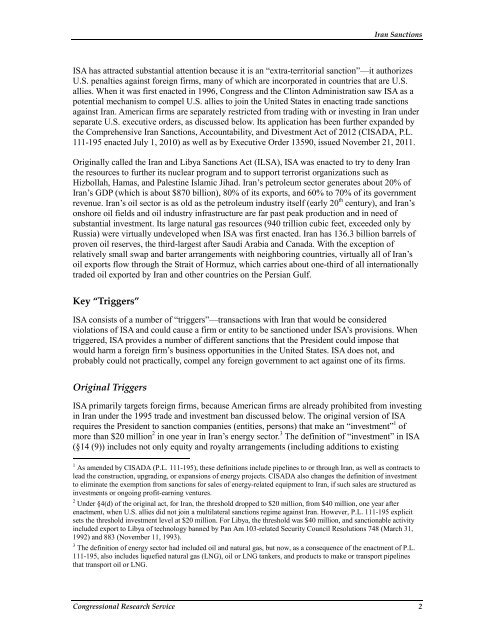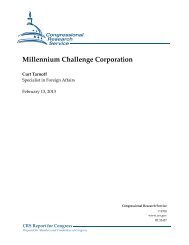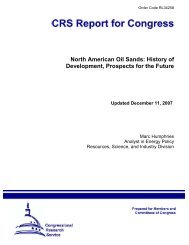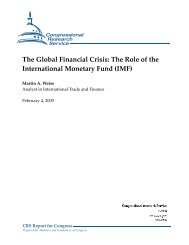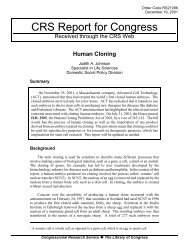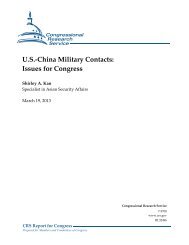Iran Sanctions - Foreign Press Centers
Iran Sanctions - Foreign Press Centers
Iran Sanctions - Foreign Press Centers
Create successful ePaper yourself
Turn your PDF publications into a flip-book with our unique Google optimized e-Paper software.
<strong>Iran</strong> <strong>Sanctions</strong><br />
ISA has attracted substantial attention because it is an “extra-territorial sanction”—it authorizes<br />
U.S. penalties against foreign firms, many of which are incorporated in countries that are U.S.<br />
allies. When it was first enacted in 1996, Congress and the Clinton Administration saw ISA as a<br />
potential mechanism to compel U.S. allies to join the United States in enacting trade sanctions<br />
against <strong>Iran</strong>. American firms are separately restricted from trading with or investing in <strong>Iran</strong> under<br />
separate U.S. executive orders, as discussed below. Its application has been further expanded by<br />
the Comprehensive <strong>Iran</strong> <strong>Sanctions</strong>, Accountability, and Divestment Act of 2012 (CISADA, P.L.<br />
111-195 enacted July 1, 2010) as well as by Executive Order 13590, issued November 21, 2011.<br />
Originally called the <strong>Iran</strong> and Libya <strong>Sanctions</strong> Act (ILSA), ISA was enacted to try to deny <strong>Iran</strong><br />
the resources to further its nuclear program and to support terrorist organizations such as<br />
Hizbollah, Hamas, and Palestine Islamic Jihad. <strong>Iran</strong>’s petroleum sector generates about 20% of<br />
<strong>Iran</strong>’s GDP (which is about $870 billion), 80% of its exports, and 60% to 70% of its government<br />
revenue. <strong>Iran</strong>’s oil sector is as old as the petroleum industry itself (early 20 th century), and <strong>Iran</strong>’s<br />
onshore oil fields and oil industry infrastructure are far past peak production and in need of<br />
substantial investment. Its large natural gas resources (940 trillion cubic feet, exceeded only by<br />
Russia) were virtually undeveloped when ISA was first enacted. <strong>Iran</strong> has 136.3 billion barrels of<br />
proven oil reserves, the third-largest after Saudi Arabia and Canada. With the exception of<br />
relatively small swap and barter arrangements with neighboring countries, virtually all of <strong>Iran</strong>’s<br />
oil exports flow through the Strait of Hormuz, which carries about one-third of all internationally<br />
traded oil exported by <strong>Iran</strong> and other countries on the Persian Gulf.<br />
Key “Triggers”<br />
ISA consists of a number of “triggers”—transactions with <strong>Iran</strong> that would be considered<br />
violations of ISA and could cause a firm or entity to be sanctioned under ISA’s provisions. When<br />
triggered, ISA provides a number of different sanctions that the President could impose that<br />
would harm a foreign firm’s business opportunities in the United States. ISA does not, and<br />
probably could not practically, compel any foreign government to act against one of its firms.<br />
Original Triggers<br />
ISA primarily targets foreign firms, because American firms are already prohibited from investing<br />
in <strong>Iran</strong> under the 1995 trade and investment ban discussed below. The original version of ISA<br />
requires the President to sanction companies (entities, persons) that make an “investment” 1 of<br />
more than $20 million 2 in one year in <strong>Iran</strong>’s energy sector. 3 The definition of “investment” in ISA<br />
(§14 (9)) includes not only equity and royalty arrangements (including additions to existing<br />
1 As amended by CISADA (P.L. 111-195), these definitions include pipelines to or through <strong>Iran</strong>, as well as contracts to<br />
lead the construction, upgrading, or expansions of energy projects. CISADA also changes the definition of investment<br />
to eliminate the exemption from sanctions for sales of energy-related equipment to <strong>Iran</strong>, if such sales are structured as<br />
investments or ongoing profit-earning ventures.<br />
2 Under §4(d) of the original act, for <strong>Iran</strong>, the threshold dropped to $20 million, from $40 million, one year after<br />
enactment, when U.S. allies did not join a multilateral sanctions regime against <strong>Iran</strong>. However, P.L. 111-195 explicit<br />
sets the threshold investment level at $20 million. For Libya, the threshold was $40 million, and sanctionable activity<br />
included export to Libya of technology banned by Pan Am 103-related Security Council Resolutions 748 (March 31,<br />
1992) and 883 (November 11, 1993).<br />
3 The definition of energy sector had included oil and natural gas, but now, as a consequence of the enactment of P.L.<br />
111-195, also includes liquefied natural gas (LNG), oil or LNG tankers, and products to make or transport pipelines<br />
that transport oil or LNG.<br />
Congressional Research Service 2


